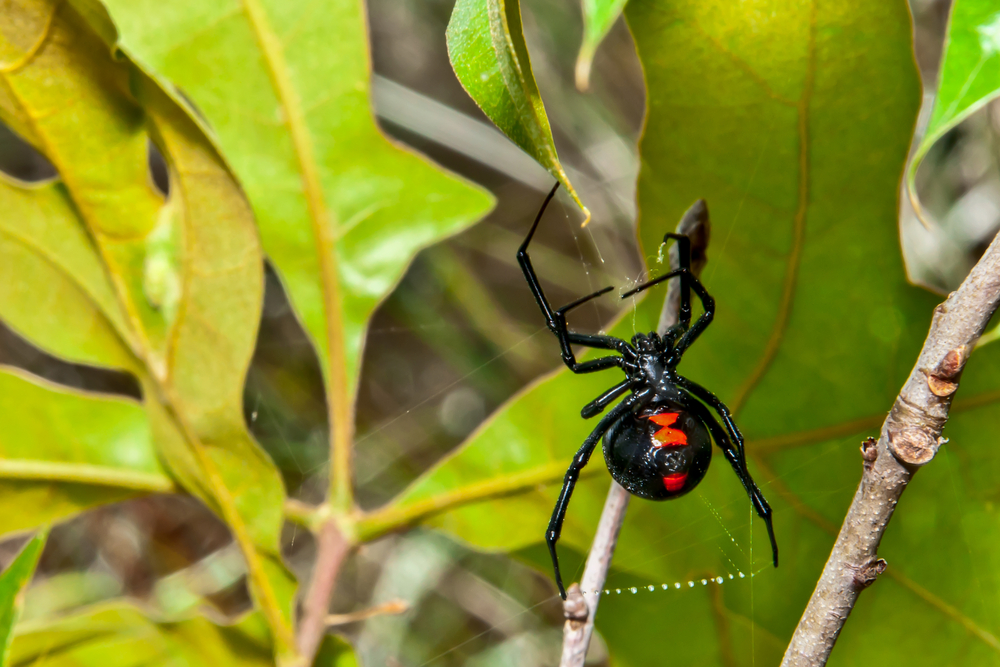Forestry & Wildlife

AUBURN UNIVERSITY, Ala. – Spiders aren’t for everyone. Some people may find them terrifying, but others may find their natural beauty stunning. An Alabama Cooperative Extension System entomologist suggests that spiders be respected and not feared. This concept is especially true for North America’s most venomous offering—the black widow.
“Lots of people fear spiders, and as a result, they get a bad reputation,” said Alabama Extension Entomologist Katelyn Kesheimer. “But that reputation is undeserved. Spiders are important predators that feed on many unwanted pests in and around our homes. Their intricate webs help trap pests such as flies and mosquitoes and provide us with free pest control.”
Identification and Life Cycle
Arguably one of the most iconic spiders in the world, the black widow spider (Latrodectus mactans) is an arthropod with an unmistakable identity. This jet-black arachnid ranges from 0.2 to 0.5 inches in size and are rarely seen. Exclusively, female black widows feature a bright red marking on the underside of the abdomen. This mark resembles an hourglass shape but may also appear as two separate red spots.
“Black widow females are prolific reproducers and often lay multiple egg sacs at a time,” Kesheimer said. “Each of these white sacs contains hundreds of eggs that will hatch into spiderlings. The spiderlings do not have the characteristic black and red coloration of the adults and instead darken from a yellow color as they get older and molt.”
After 26 to 30 days in incubation, the spiderlings emerge and disperse. Males reach full maturity in approximately two to three months; females take longer–about four to five months.
Habitat and Behavior
If the dark color or red marking wasn’t enough to identify the black widow, its web is another giveaway. Compared to symmetrical webs of orb-weaving spiders, the black widow spins an irregular, tangled mesh of threads.
“Black widows are likely more scared of us than we are of them,” Kesheimer said. “They are active at night and are often found in areas that are hidden and away from activity. Like most animals, black widows can become aggressive when protecting eggs. But even then, biting is rare. We typically only see black widow bites when they are pressed against skin.”
Black widows and their silky structures are normally found outside in quiet, and dark areas such as under rocks and debris, wood piles and under or around houses. If climates are drier than normal or cold, black widows may move into man-made habitats such as barns, garages, cellars, sheds and rain spouts.
Bite and First Aid
Should someone be bitten by a black widow, it is vital that they know about the spider’s venom and how to respond. Interestingly, the female widow is the only one that delivers a bite. Males and juveniles do not bite at all.
“Bites are rare and used as a defensive response by black widows when they are trapped against bare skin,” Kesheimer said. “Their saliva contains a neurotoxin that can cause mild pain at the site or in nearby muscles. Some may experience something similar to a mild flu, but symptoms are usually gone within half a day. Children and those with compromised immune systems are at the highest risk of developing worsening symptoms.”
She adds that people rarely die from the bite. Children who weigh less than 30 pounds are of the greatest risk to black widow venom. Anyone who has been bitten by a spider should heed the following instructions.
- Clean the wound using mild soap and water and apply an antibiotic ointment to prevent infection.
- Use a cool compress or ice pack to reduce the swelling in the area surrounding the bite.
- A doctor may recommend a tetanus booster shot if not vaccinated in the last five years.
Black Widow Control
The best approach to controlling not only black widows, but all spiders, is Integrated Pest Management (IPM).
“IPM is all about using multiple tools to manage pests,” Kesheimer said. “While pesticides are useful against pests, there are more effective tools for black widows. If you’re working in the garden or outside your home where black widows may be hiding, keep an eye out for their distinct coloration and webs. Avoid putting bare skin against the ground in these areas and consider long sleeves, pants or gloves.”
If a black widow is spotted in an undesired area, sanitation is recommended. Performing cleaning methods will mitigate breeding grounds. Be sure to remove spiders, webs and egg sacs by vacuuming. It is important to note that if vacuuming, empty the bag with the motor still running. Air pollution and spiders will not escape if executed properly.
Cracks and crevices may also be sealed to cut off pathways into a home or structure. These entrances could be windowsills, door thresholds and around piping. Tight-fitting screens are also effective on attic and foundation vents.
For serious black widow infestations, use pesticides labeled appropriately for spider control. Pyrethroids can be used to spot clean sites and corners where webs were previously constructed. Always follow the instructions label on the product when using chemicals.
Learn More
Spread these pest management tips with neighbors to help prevent any unwanted, crawly guests. To learn more about the black widow as well as other spiders, visit the Alabama Extension website at www.aces.edu.

